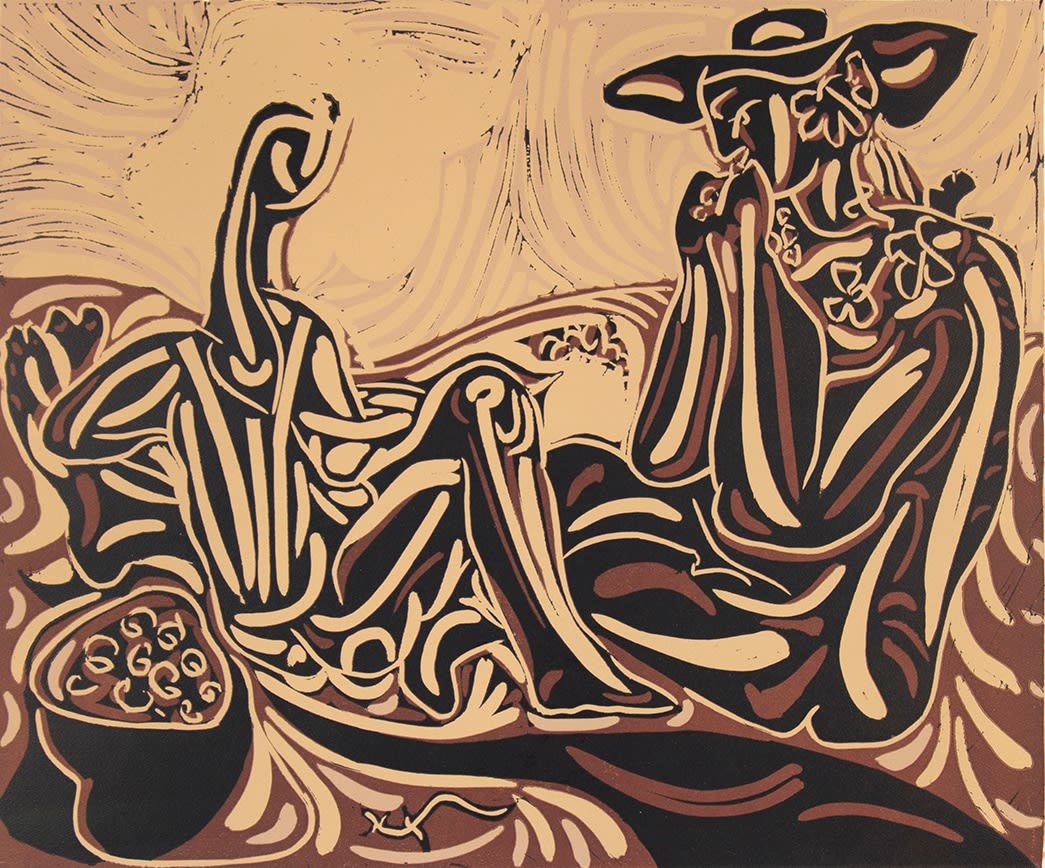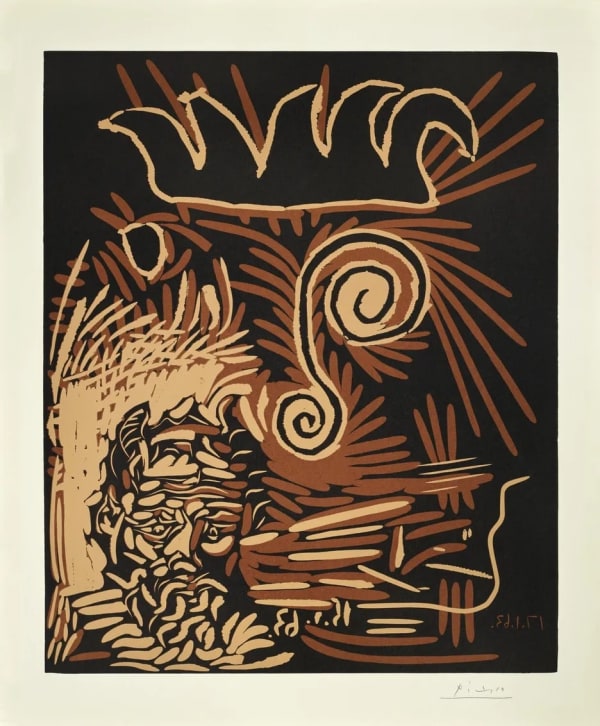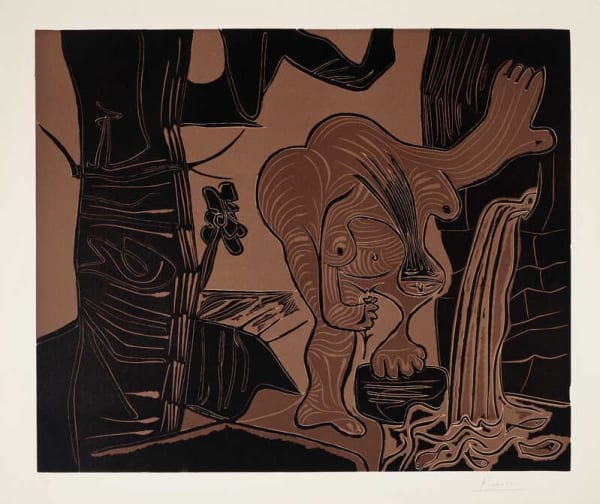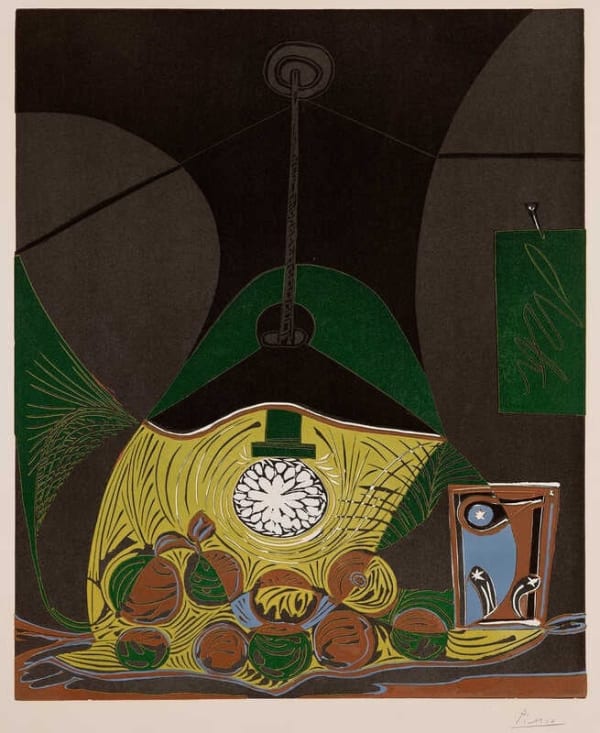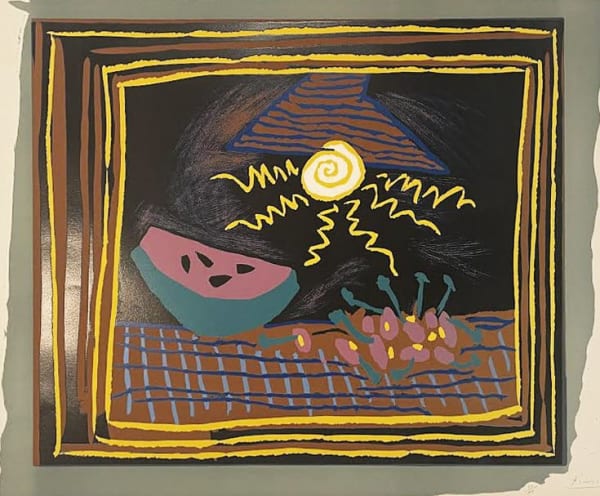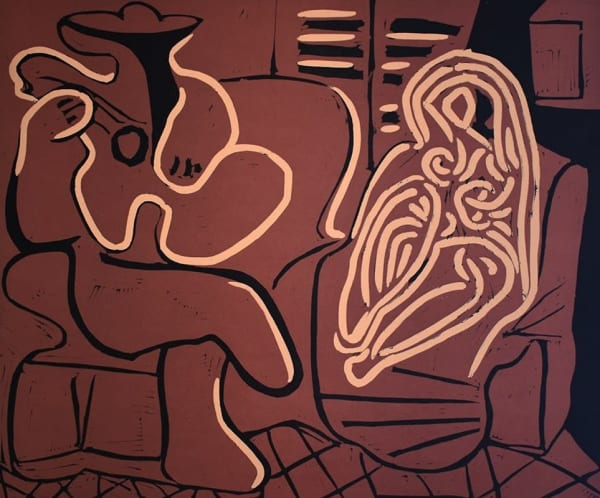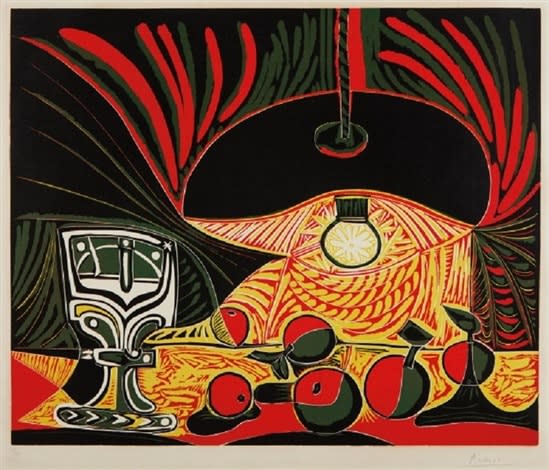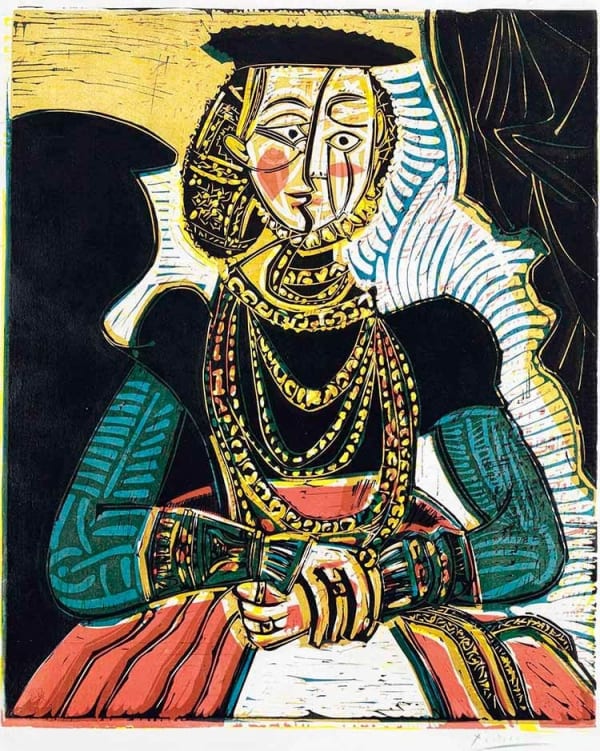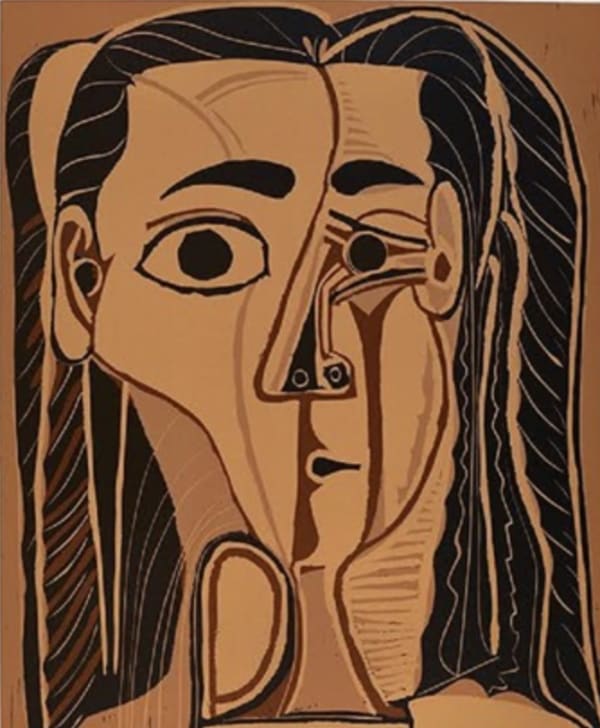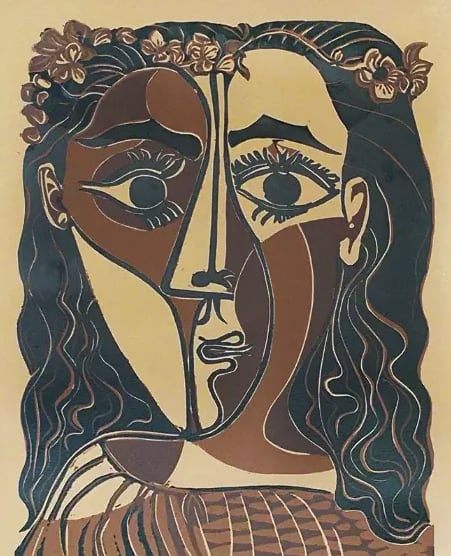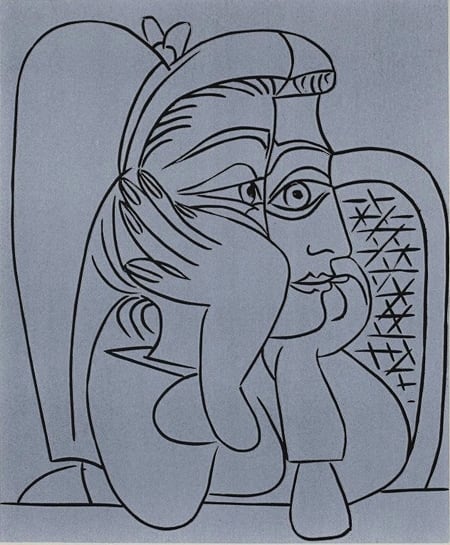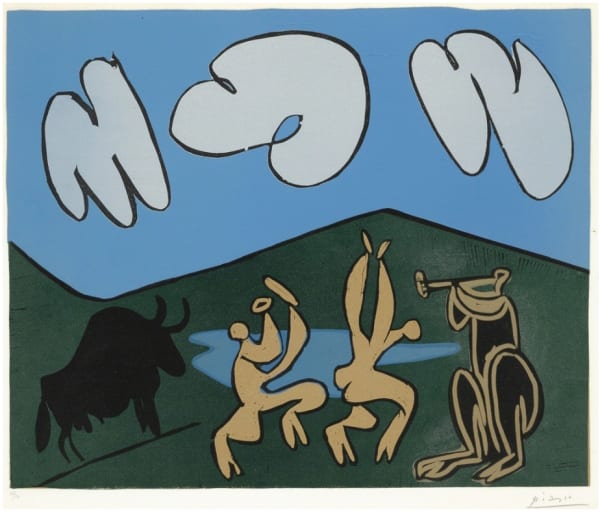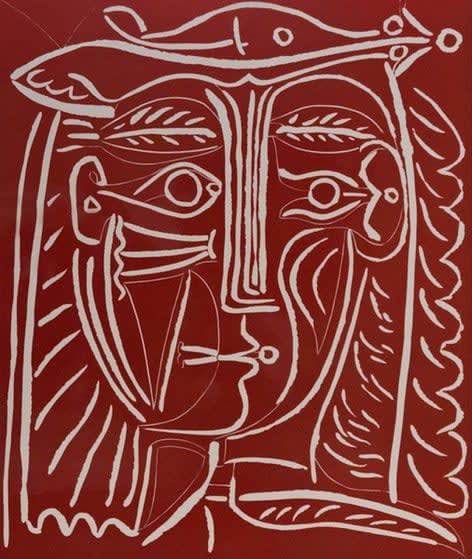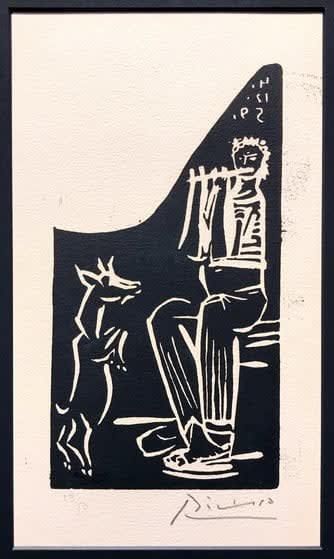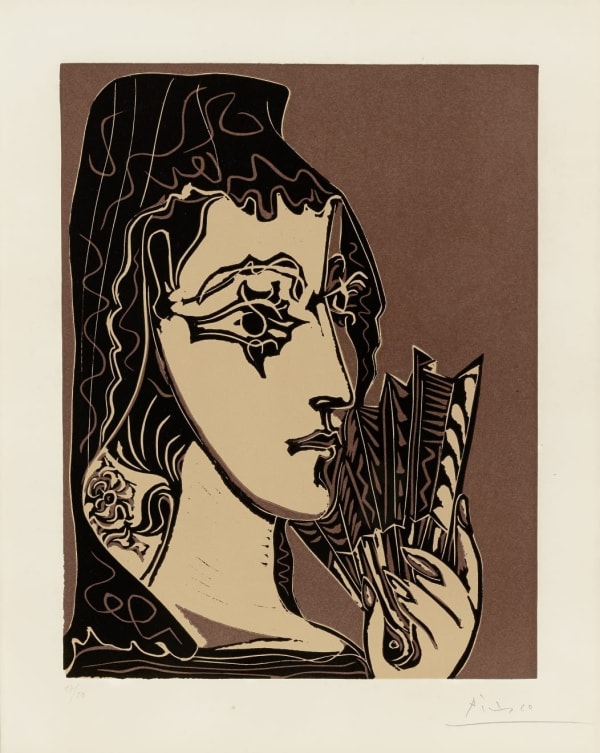-
Artworks

Pablo Picasso
Les vendangeurs, 1959Color Linocut on Arches Wove PaperImage: 25 1/8 in x 20 3/4 in (63.8 cm x 52.7 cm)
Sheet: 29 1/2 x 22 1/2 in (74. 9 cm x 57.1 cm)Edition of 50 + 20 APSeries: LinocutCopyright The ArtistCreated in 1959, Les vendangeurs (The Grape Harvesters) is a striking example of Pablo Picasso’s late-career mastery of the linocut, a printmaking technique that he helped to revolutionize. The work...Created in 1959, Les vendangeurs (The Grape Harvesters) is a striking example of Pablo Picasso’s late-career mastery of the linocut, a printmaking technique that he helped to revolutionize. The work captures a pastoral moment — two stylised figures reclining in a vineyard during harvest time — but its execution is anything but traditional. Here, Picasso transforms a timeless rural subject into an abstract, rhythmic composition that pulses with vitality, combining his deep understanding of form with his innovative approach to graphic art.
The composition is dominated by two central figures. On the left, a reclining harvester leans back, knees bent, torso twisting in a dynamic pose. Their form is articulated through bold, ribbon-like contours that flow across the body, creating a sense of movement even in repose. A basket brimming with grapes sits nearby, its rounded shapes contrasting with the sharp linearity of the figure. Opposite them, a second figure — wearing a broad-brimmed hat adorned with flowers — sits upright, hands raised to the face in a gesture that suggests tasting or contemplating the grapes. The hat’s exaggerated brim and floral decoration add a festive, almost theatrical note to the rural scene.
The background, though reduced to essential curves and swirling lines, suggests the undulating landscape of a vineyard under a luminous sky. Picasso’s carved marks mimic the fluid movement of wind, the curvature of hills, and the tactile richness of grape-laden vines. This combination of figuration and abstraction allows the viewer to sense both the specific act of harvesting and the timeless rhythm of agricultural life.
Technically, Les vendangeurs is a tour de force of linocut printmaking. By the late 1950s, Picasso had not only mastered the medium but had also developed his own distinctive method: the reduction or suicide linocut. Rather than carving multiple linoleum blocks for different colors, Picasso worked with a single block, progressively cutting away sections after each color was printed. This required an exacting level of planning and precision, as there was no possibility of correction once material was removed. The artist’s complete control over this process is evident in the harmonious interplay of tones here — deep black, rich brown, and the warm beige of the untouched paper — which combine to create a sculptural depth and tactile warmth.
The reduction technique also allowed Picasso to work with flowing, interconnected shapes, as seen in the way the figures’ forms and the surrounding environment merge into a unified design. The interplay of positive and negative space is particularly striking: areas of flat color alternate with intricate carved lines, giving the composition both solidity and dynamism.
Thematically, Les vendangeurs fits within Picasso’s broader interest in scenes of rural labor, leisure, and festivity, which he explored throughout his career in paintings, drawings, ceramics, and prints. The grape harvest, with its connotations of abundance, celebration, and the cycles of nature, provided an opportunity for Picasso to merge the human form with organic motifs. This blending of human and natural rhythms is a hallmark of his mature style, reflecting both his classical roots and his modernist sensibility.
What makes Les vendangeurs particularly compelling is its balance between immediacy and refinement. The sweeping curves and bold contrasts convey a sense of spontaneous energy, as if the scene were unfolding before us, yet the precision of the carving and the careful orchestration of colors reveal a meticulous, deliberate craftsmanship. This duality — spontaneity anchored by control — is one of the defining features of Picasso’s printmaking genius.
By 1959, Picasso had been living in the south of France for over a decade, immersed in the Mediterranean landscape and culture. Works like *Les vendangeurs* reflect the vitality of this environment, its traditions, and its people. At the same time, the piece transcends its local setting, becoming a universal image of human connection to the land and the pleasures of harvest.
Ultimately, Les vendangeurs stands as a testament to Picasso’s ability to breathe new life into an ancient theme through the modern medium of linocut. His technical mastery, combined with his unerring sense of form and movement, transforms a simple rural subject into an artwork of enduring elegance and energy — a celebration not only of the grape harvest but of the creative harvest of an artist at the height of his powers.
Thematically, Picasso’s engagement with Manet’s work reflects his broader practice of reinterpreting the masters. Throughout his career, Picasso returned to canonical artworks — from Velázquez’s Las Meninas to Delacroix’s Women of Algiers — not to copy them, but to engage in a visual dialogue across centuries. In doing so, he asserted himself as both a student and a rival of the greats, probing their compositions, altering their narratives, and reasserting their relevance in a modern context. With Le Déjeuner sur l’herbe, he channels Manet’s spirit of defiance and modernity while filtering it through his own post-Cubist sensibility.
The result is a work that is both homage and reinvention. By paring away extraneous detail, Picasso focuses on the timeless human drama at the heart of Manet’s original — the interplay of gazes, the subtle gestures, the quiet yet charged intimacy of a group sharing space. Through the bold physicality of the linocut, these relationships are rendered with a monumental solidity that transcends the casual setting of a picnic.
Ultimately, Le Déjeuner sur l’herbe d’après Edouard Manet stands as a testament to Picasso’s dual mastery — as an interpreter of art history and as a printmaker of extraordinary skill. His ability to honor a masterwork while utterly transforming it into something unmistakably his own reflects not only his technical command but also his deep understanding of how images live, evolve, and speak across time. This 1954 linocut is a bridge between past and present, between Manet’s radical realism and Picasso’s modernist boldness, carved with the precision and confidence of a true master of the graphic arts.
For more information on Les vendangeurs (The Grape Harvesters) by Pablo Picasso for sale, contact our galleries using the form below.
%3Cdiv%20class%3D%22artist%22%3EPablo%20Picasso%3C/div%3E%3Cdiv%20class%3D%22title_and_year%22%3E%3Cspan%20class%3D%22title_and_year_title%22%3ELes%20vendangeurs%3C/span%3E%2C%20%3Cspan%20class%3D%22title_and_year_year%22%3E1959%3C/span%3E%3C/div%3E%3Cdiv%20class%3D%22medium%22%3EColor%20Linocut%20on%20Arches%20Wove%20Paper%3C/div%3E%3Cdiv%20class%3D%22dimensions%22%3EImage%3A%2025%201/8%20in%20x%2020%203/4%20in%20%2863.8%20cm%20x%2052.7%20cm%29%3Cbr/%3E%0ASheet%3A%2029%201/2%20x%2022%201/2%20in%20%2874.%209%20cm%20x%2057.1%20cm%29%3C/div%3E%3Cdiv%20class%3D%22edition_details%22%3EEdition%20of%2050%20%2B%2020%20AP%3C/div%3E%3Cdiv%20class%3D%22series%22%3E%3Cspan%20class%3D%22artwork_caption_prefix%22%3ESeries%3A%3C/span%3E%20Linocut%3C/div%3ERelated artworks-
 Pablo PicassoTwo Women by the Window | Deux femmes près de la fenêtre, 1959
Pablo PicassoTwo Women by the Window | Deux femmes près de la fenêtre, 1959 -
 Pablo PicassoWoman Reclining and Man with a Guitar | Femme couchée et homme à la guitare, , 1959
Pablo PicassoWoman Reclining and Man with a Guitar | Femme couchée et homme à la guitare, , 1959 -
 Pablo PicassoJacqueline au chapeau de paille, 1962
Pablo PicassoJacqueline au chapeau de paille, 1962 -
 Pablo PicassoLe Vieux bouffon, 1963
Pablo PicassoLe Vieux bouffon, 1963 -
 Pablo PicassoHomme au batôn / Le Vieux bouffon, 1963
Pablo PicassoHomme au batôn / Le Vieux bouffon, 1963 -
 Pablo PicassoFemme nue à la source, 1963
Pablo PicassoFemme nue à la source, 1963 -
 Pablo PicassoNature morte à la suspension, 26 mars, 1962
Pablo PicassoNature morte à la suspension, 26 mars, 1962 -
 Pablo PicassoTaureau et Picador, 1959
Pablo PicassoTaureau et Picador, 1959 -
 Pablo PicassoFemme au Chapeau (Portrait de Jacqueline au chapeau de paille multicolore)., 1962
Pablo PicassoFemme au Chapeau (Portrait de Jacqueline au chapeau de paille multicolore)., 1962 -
 Pablo PicassoLe Déjeuner sur l'herbe d'aprés Edouard Manet. (The Luncheon on the Grass after Edouard Manet), 1954
Pablo PicassoLe Déjeuner sur l'herbe d'aprés Edouard Manet. (The Luncheon on the Grass after Edouard Manet), 1954 -
 Pablo PicassoBoy with a Crown of Leaves | Jeune homme couronné de feuillage, 1959
Pablo PicassoBoy with a Crown of Leaves | Jeune homme couronné de feuillage, 1959 -
 Pablo PicassoLe Vieux Roi (B. 1152) (The Old King) , 1963
Pablo PicassoLe Vieux Roi (B. 1152) (The Old King) , 1963 -
 Pablo PicassoNature Morte a la Pasteque, 1962
Pablo PicassoNature Morte a la Pasteque, 1962 -
 Pablo PicassoAubade, with a Woman in an Armchair | L'aubade, avec femme dans un fauteuil, 1959
Pablo PicassoAubade, with a Woman in an Armchair | L'aubade, avec femme dans un fauteuil, 1959 -
 Pablo PicassoL'Aubade, avec Femme Accoudee, 1959
Pablo PicassoL'Aubade, avec Femme Accoudee, 1959 -
 Pablo PicassoNu Assis, 1962
Pablo PicassoNu Assis, 1962 -
 Pablo PicassoPortrait De Jacqueline (Bloch 923), 1959
Pablo PicassoPortrait De Jacqueline (Bloch 923), 1959 -
 Pablo PicassoPortrait de Jacqueline Au Chapeau De Paille Fleuri, 1962
Pablo PicassoPortrait de Jacqueline Au Chapeau De Paille Fleuri, 1962 -
 Pablo PicassoLa Pique en Rouge et Jaune (The Bullfight in Red and Yellow), 1959
Pablo PicassoLa Pique en Rouge et Jaune (The Bullfight in Red and Yellow), 1959 -
 Pablo PicassoJacqueline au Bandeau, 1962
Pablo PicassoJacqueline au Bandeau, 1962 -
 Pablo PicassoNature Morte Au Verre Sous La Lampe, 1962
Pablo PicassoNature Morte Au Verre Sous La Lampe, 1962 -
 Pablo PicassoBuste de Femme d'après Cranach le Jeune, (Bloch 859), 1958
Pablo PicassoBuste de Femme d'après Cranach le Jeune, (Bloch 859), 1958 -
 Pablo PicassoPortrait de Jacqueline Accoudée, 1959
Pablo PicassoPortrait de Jacqueline Accoudée, 1959 -
 Pablo PicassoGrande Tete De Femme (Bloch 1069), 1962
Pablo PicassoGrande Tete De Femme (Bloch 1069), 1962 -
 Pablo PicassoPetite Tête de Femme Couronnée, `962
Pablo PicassoPetite Tête de Femme Couronnée, `962 -
 Pablo PicassoFemme Accoudée (Bloch 922) , 1959
Pablo PicassoFemme Accoudée (Bloch 922) , 1959 -
 Pablo PicassoJacqueline au Bandeau, 1962
Pablo PicassoJacqueline au Bandeau, 1962 -
 Pablo PicassoWatermelon Still Life, 1962
Pablo PicassoWatermelon Still Life, 1962 -
 Pablo PicassoDeux Femmes Prés de la Fenêtre , 1959
Pablo PicassoDeux Femmes Prés de la Fenêtre , 1959 -
 Pablo PicassoBacchanale au Hibou (bloch 938), 1959
Pablo PicassoBacchanale au Hibou (bloch 938), 1959 -
 Pablo PicassoBacchanale au Taureau Noir (Bloch 935), 1959
Pablo PicassoBacchanale au Taureau Noir (Bloch 935), 1959 -
 Pablo PicassoTête de Femme au Chapeau , 1962
Pablo PicassoTête de Femme au Chapeau , 1962 -
 Pablo PicassoFaune et Chévre, 1959
Pablo PicassoFaune et Chévre, 1959 -
 Pablo PicassoPortrait de Femme a la Fraise et au Chapeau , 1962
Pablo PicassoPortrait de Femme a la Fraise et au Chapeau , 1962 -
 Pablo PicassoL'Etreinte (Bloch 1150), 1963
Pablo PicassoL'Etreinte (Bloch 1150), 1963 -
 Pablo PicassoPortrait de Jacqueline en Carmen (L'Espagnole) , 1962
Pablo PicassoPortrait de Jacqueline en Carmen (L'Espagnole) , 1962
-
Join our mailing list
* denotes required fields
We will process the personal data you have supplied in accordance with our privacy policy (available on request). You can unsubscribe or change your preferences at any time by clicking the link in our emails.
This website uses cookies
This site uses cookies to help make it more useful to you. Find out more about cookies.
